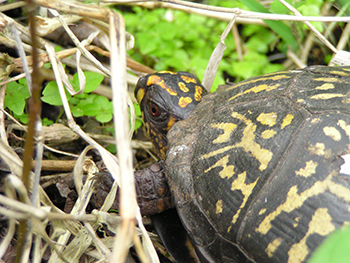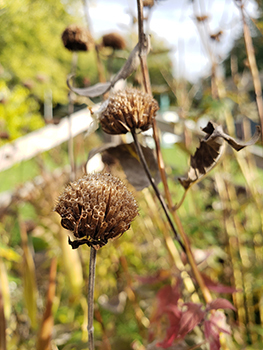Don’t burn that butterfly’s blankie!
Leaf litter is the one kind of litter conservationists encourage
By RACHEL COALE, EMMA KUKUK and RACHEL LEIGHTNER
Michigan Department of Natural Resources
A cold palace, solitude and a queen.
This story may seem familiar, but we’re not talking about magical Elsa from Disney’s “Frozen.”
The queen in question is a bumblebee, and she has a request for you: When it comes to fall leaves, “let it go.”

Allow us to explain.
Fuzzy bumblebees that bounce from clovers to coneflowers are among many Michigan insects and wildlife that seek shelter over the winter.
While some species, like the celebrated monarch butterfly with its colorful wing patterns resembling stained glass, make incredible journeys across the continent to warmer regions, many remain here.
But where do they go when winter weather swaps out floating butterflies for drifting snowflakes? The answer is right below our feet.
The splendid fall color season leaves a stash of freshly fallen leaves on the ground. They’re important for woodland species including insects, amphibians and small mammals over the cold months.
Who lives in leaves?
Picture a leaf pile. It looks kind of dead, brown and boring, right? That is exactly what wild bees, luna moths and salamanders want you to think.
Luna moths and swallowtail butterflies cleverly disguise their cocoons as dried leaves. With their shabby, brown color and ragged texture, you’d never know there was a colorful, winged creature waiting inside.
Woolly bear caterpillars (the fuzzy black and orange ones that, according to legend, predict winter weather), creeping beetles and fluttering moths and butterflies all rely on leaves for different stages of their lives, whether they hide among the foliage or simply eat leaves.
|

Salamanders, toads and frogs have a similar strategy, burrowing under the leaves and into the moist ground to ride out the winter. So do the young of one of Michigan’s rare turtle species.
“Eastern box turtle hatchlings, Michigan’s only true land-based turtle, hibernate under leaf litter their first winter after hatching,” said DNR biologist Thomas Goniea.
Unlike their aquatic counterparts, these black-and-yellow-patterned turtles can be found in the forest instead of lakes and ponds.
A cold palace fit for a queen
Like Elsa’s dramatic retreat to her frozen palace, the bumblebee queen also seeks solitude in winter.
As summer fades to fall, the bumblebee queen turns her attention to stocking up on pollen and nectar, building up fat and filling her honey stomach, which is a reservoir for honey. This gives her nutrition through the winter.
She also needs a suitable underground burrow to hibernate in. Bumblebees are a social species, but the bumblebee queen hibernates alone. Bumblebees dig in vegetation and loose soil, so the location they choose is paramount.
It must be protected, and never in a place that could be warmed by the winter sun, which could trick her into waking up too early.
Bumblebees, including the rusty-patched bumblebee, which was added to the federal list of threatened and endangered species in 2017, are in decline due to a variety of factors.
This bee is among 20 kinds of bumblebees native to Michigan as recorded by the Michigan Natural Features Inventory.
Others among them are the northern amber bumblebee and the Sanderson’s bumblebee. By leaving a layer of leaf litter, you’ll provide a protected and shaded burrow for the bumblebee queen, helping ensure the next generation of bees in spring.
Embrace leafy chaos
|

So, what would the bumblebee queen have you do?
As you wrap up the garden year and pack away hammocks and outdoor furniture, try not to be too orderly – nature likes a bit of mess.
Consider leaving fall leaves where they land or raking them into your garden beds instead of burning them. They will provide nutrients and control soil erosion while creating spaces for winter dwellers to snuggle up until spring.
If you have enough space, establish a small “wild area” in a remote part of your yard where you toss fallen limbs, stumps and twigs to invite wildlife.
Native bees, butterflies, moths and spiders will take up residence. By providing carpenter bees with a natural wood source, you might even lure them away from doing their namesake work in your deck or siding.
Many of these small insects are the base of the food chain and will support many other wildlife species, including frogs, toads, turtles, chipmunks and birds – all the way up to the “top of the food chain” species, such as the bald eagle, black bear and coyote.
Leaves aren’t the only way you can help wildlife – with mason bees, think vertically. These gentle bees overwinter in the hollow stems of plants. Leaving perennial stems to wave and rattle in the breeze will give them places to hang out, and seedheads from flowers will provide treats for hungry chickadees and finches.
Check out Leave the Leaves to Benefit Wildlife from the Xerces Society, a nonprofit organization dedicated to conserving invertebrate species like pollinators and other bugs, to learn more about the importance of fall leaves and plants to healthy ecosystems.
Alternatives
|

If you know your neighborhood homeowners’ association will go bonkers at the thought of an unmaintained wild area, there are still ways to be kind to bugs and other wildlife as they prepare for the long winter.
“Leaving the leaves doesn’t mean sacrificing your yard to the wilderness,” according to the Xerces Society’s winter habitat webpage.
Tidy your yard, but maintain habitat and leaf litter by raking leaves around the bases of trees and bushes. Stone or branch edging will help keep them in place even when the wind blows.
You can also choose plants with ornamental value that you won’t need to cut down until spring. Leave them in the ground or place them in pots so they can be moved somewhere undisturbed through winter, like behind a shed.
Bee balm, butterfly weed and coneflowers are picks that pollinators and songbirds will love. It’s safe to clean stems up in the spring, when temperatures are consistently warm and new greenery has begun to reach upward out of the mulch and leaf litter.
If anyone asks why you’re putting the rake away this fall and letting nature’s colors decorate your yard, let them know that you’re promoting littering – the good kind!
|
Check out previous Showcasing the DNR stories in our archive at Michigan.gov/DNRStories. To subscribe to upcoming Showcasing articles, sign up for free email delivery at Michigan.gov/DNREmail.
Note to editors: Contact: John Pepin, Showcasing the DNR series editor, 906-226-1352. Accompanying photos and a text-only version of this story are available below for download. Caption information follows. Credit Michigan Department of Natural Resources, unless otherwise noted.
Text-only version of this story.
Bee balm and coneflower: Some plants with ornamental value don’t need to be cut down until spring and can be left in the ground or placed in pots so they can be moved somewhere undisturbed through winter. Bee balm, butterfly weed and coneflowers are picks that pollinators and songbirds will love. (Both photos by Rachel Coale)
Bumblebee: A bumblebee gathers nectar from an aster flower. There are 20 kinds of bumblebees native to Michigan, and leaving a layer of leaf litter can provide a protected and shaded burrow for the bumblebee queen, helping ensure the next generation of bees in spring. (Photo by Rachel Coale)
Leaves: Fallen leaves on the ground are important for woodland species including insects, amphibians and small mammals over the cold months. (Photo by Rachel Coale)
Luna: Luna moths, like the one pictured here, and swallowtail butterflies cleverly disguise their cocoons as dried leaves to protect them. (Photo from U.S. Fish and Wildlife Service)
Salamander_leaf and Spotted_salamander: Salamanders, toads and frogs burrow under leaves and into the moist ground to hide and ride out the winter. (Salamander_leaf photo by Jessica Roy)
Turtle: Michigan’s only true land-based turtle, eastern box turtle hatchlings hibernate under leaf litter their first winter after hatching.
|